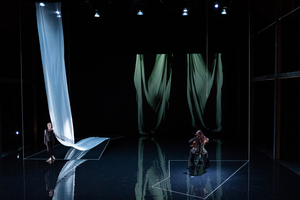Review: THE DAY at Kennedy Center Eisenhower Theater

Late in the second part of THE DAY, a 75-minute, multi-media theatre piece in the Kennedy Center's Eisenhower Theater, a tall, white rectangle of fabric unfurls from above the stage. After dancer Wendy Whelan partners with it for a while, the fabric crumples to the stage floor. Previously, Whelan, clad in a black garment designed by Karen Young, had worked in front of the absolute best of Joshua Higgason's several projections; to backdrop Whelan, Higgason created a collage in motion of the interior of The Oculus, Santiago Calatrava's cathedral-like structure built above the replacement PATH and subway stations, both of which were destroyed when the World Trade Center towers collapsed into them. Scenic designer Sara Brown has scaled her fabric tower to suggest one of the buildings that fell. Some of Lucinda Childs' choreography for Whelan puts the dancer onto the balls of her feet and significantly off-balance, with arms asymmetrical-the way someone might struggle down a damaged stairwell. As Sondheim says, "Art isn't easy," But when great artists choose the allusive over the literal as Childs, Higgason, and Brown do, art can effortlessly take the breath away.
Childs' genius during her more than 50-year has career been lauded globally; it makes a writer grumpy, while preparations for this year's Kennedy Center Honors take place in the house next door, that 79 year old Lucinda Childs has not been invited to join this particularly American rainbow collection. Childs, whose athletic and variegated style could be described as both "Tharpish" and "Martha Graham goes casual," gives Wendy Whelan so much to do! And that's because Whelan can do anything and/or everything. Liberated from toe shoes after her 30-year career with New York City Ballet (she's now the Associate Artistic Director of the Company), Whelan can now explore other choreographic dialects and vocabularies. In this piece, Childs sets her free-in space, on the floor, on a ramp, with fabric as her partner, and to wrangle two slim rods like those some puppeteers use. The occasional ronde de jambe or balletic port de bras only underscores the infinite quantities of movement audiences have not yet seen Whelan execute; it's a feast, and Childs must surely be winking puckishly offstage.
Whelan wears white in the first part. Brown has fashioned an infinity scarf with a circumference of 5 feet for Whelan to inhabit in multiple ways: she walks on it, dances in it, shapes it with her arms. Martha Graham introduced stretch jersey by the yard to dance costuming, and Whelan and her fabric companion will make old dance hands in the audience recall Frontier and Letter to the World.
The text of THE DAY is its own kind of letter to the world; alas, when one "crowd sources from the Internet," as the program says composer David Lang has done, one obtains an often banal list rather than poetry. A Whitman or an Allen Ginsburg might have created art from this verbal soup; Lang has merely culled a batch of sentences which fill in the blank after the stem "I remember the day I. . . ." Voiced loudly through speakers every six seconds, the text competes to be heard over the equally loud cello music by Lang, played partly live and amplified and partly pre-recorded by Maya Beiser. These elements cannot compete (though they try) with Whelan and Childs. There seems minimal connection among text, score, choreography, and dancer during Part 1; it is a relief when the text stops.
David Lang, who teaches composition at Yale and is in residence at Princeton, won a Pulitzer Prize for his choral piece the little match girl passion. His score for THE DAY gives a fine cellist tuneless, monotonous notes to play, though creating an adagio for the somber second part suits the tone of that section. Beiser, who conceived THE DAY, has the chops to give audiences splendid acoustic Bach, Hayden, or Dvorak. However, by including Higgason's projections of a cello seeming to commit suicide, she implies different career goals. Perhaps after taking off her "toe shoes" for a while, audiences will one day be able to hear Beiser in a more musicianly context. The dry score for THE DAY really seems targeted to appeal to those who prefer sound design to music. Childs and Whelan work in a different stratosphere where they make beauty.
THE DAY repeats December 7 at 8 pm; for tickets and information, visit kennedy-center.org or call 202.467.4600.
(This production contains cello abuse, though no actual cellos were harmed-I hope.)
Photo by Hayim Heron, courtesy of Jacobs Pillow
Videos
